As I'm about to have my visit #5000 I thought I'd celebrate with my favourite cake - Cheesecake. I know 5000 might not be that much (and half of them are probably myself), but for a small independent blog that started just as an extension to some recipes I posted on Facebook, I'm quite content. And to say thank you to everyone who has ever visited Skytte's Kitchen, I'd like to invite you for a slice of cake... if you make it yourself, obviously. I have tried various recipes for cheesecake, all good, but some a bit heavy, others a bit flavourless. But then I tried making a cheesecake I saw on Alton Brown's programme Good Eats, and bam! there was the perfect combination: Light (in texture, not in calories), creamy, flavourful. Try it out, you won't regret... Start by turning on your oven at 150ºC.
Ingredients:
Base:
35 Biscuits (Graham's, Marie, or Digestives)
120ml Melted Butter
1 tbsp. White Sugar
Cake:
350ml Sour cream
570g Philadelphia Cream Cheese
240 ml Sugar
80ml Cream
1 tbsp Vanilla
3 Egg Yolks
2 Whole Eggs
Topping:
Any jam of your liking
Ingredients:
Base:
35 Biscuits (Graham's, Marie, or Digestives)
120ml Melted Butter
1 tbsp. White Sugar
Cake:
350ml Sour cream
570g Philadelphia Cream Cheese
240 ml Sugar
80ml Cream
1 tbsp Vanilla
3 Egg Yolks
2 Whole Eggs
Topping:
Any jam of your liking
 Start by crushing the biscuits finely. I used to put them in a plastic bag and hammer them with a rolling pin. The result is what you see in the picture: lots of big chunks. It's OK, but since I've got a food processor, It seems to do the job even more finely and leaving less a mess. Mix it with the sugar and the melted butter until it has the consistency of wet sand.
Start by crushing the biscuits finely. I used to put them in a plastic bag and hammer them with a rolling pin. The result is what you see in the picture: lots of big chunks. It's OK, but since I've got a food processor, It seems to do the job even more finely and leaving less a mess. Mix it with the sugar and the melted butter until it has the consistency of wet sand.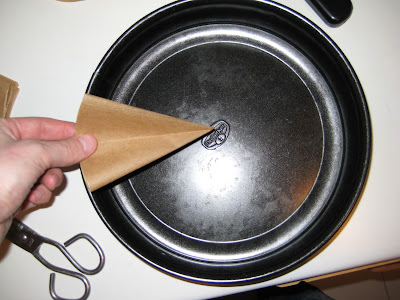 Get out your spring form, fold up a piece of baking paper and cut it at the radius of the form.
Get out your spring form, fold up a piece of baking paper and cut it at the radius of the form.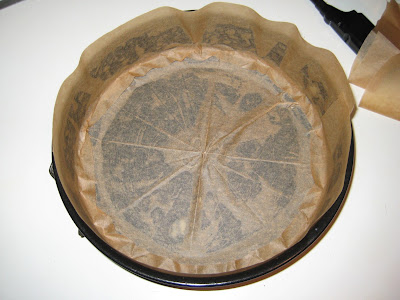 Unfold it and stick it to the base with a bit of water or butter. Cut a long strip for the sides. This will make it so much easier to remove the cake once done.
Unfold it and stick it to the base with a bit of water or butter. Cut a long strip for the sides. This will make it so much easier to remove the cake once done.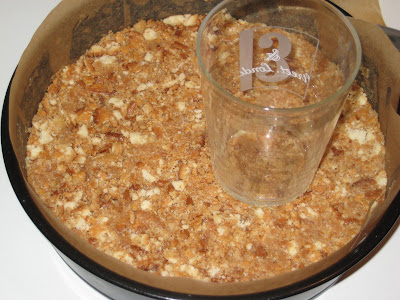 Put the biscuit mix in, hammer it down with the base of a glass so it's firm and equally thick all over. Bake it for 10 minutes at 150ºC.
Put the biscuit mix in, hammer it down with the base of a glass so it's firm and equally thick all over. Bake it for 10 minutes at 150ºC. Meanwhile, pour your sour cream into a bowl. Mix it for a minute at mid speed just by it self. this will help loosen it up.
Meanwhile, pour your sour cream into a bowl. Mix it for a minute at mid speed just by it self. this will help loosen it up. Add the cream cheese and the sugar. Mix it well, first at slow speed, then at medium until smooth. Scrape down the sides and mix a bit more.
Add the cream cheese and the sugar. Mix it well, first at slow speed, then at medium until smooth. Scrape down the sides and mix a bit more.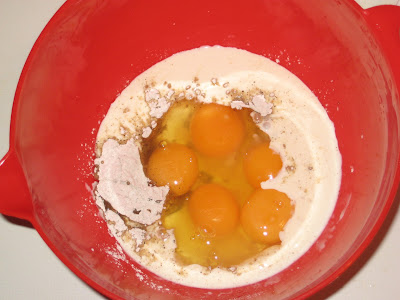 In a second bowl, mix the cream, vanilla, yolks and eggs. If the eggs are small, add another yolk. Beat well until smooth, light and creamy.
In a second bowl, mix the cream, vanilla, yolks and eggs. If the eggs are small, add another yolk. Beat well until smooth, light and creamy. Pour half of the egg mixture into the cheese, mix and scrape down the sides. I keep insisting on scraping down the sides and bottom as you might have lumps of unmixed cheese. Then add the rest of the eggs and mix.
Pour half of the egg mixture into the cheese, mix and scrape down the sides. I keep insisting on scraping down the sides and bottom as you might have lumps of unmixed cheese. Then add the rest of the eggs and mix. Pour over the baked biscuit base. Tap the whole thing lightly against the table so the bubbles will flow to the top. Reduce the heat of the oven to 120ºC. According to the original recipe you have to place the cake in a bain-marie. I don't have another recipient which is big enough to hold the spring form. If you do, great. Just make sure your spring form is water proof, or you'll have a soggy base. Bake at 120º for 1 hour. Then turn off the oven but leave the cake inside for an hour more. If you're a perfectionist the centre should have reached (but not surpassed) 65º. Take the cake out and let it cool down completely! It might seem a bit soft but that should all be good once it settles.
Pour over the baked biscuit base. Tap the whole thing lightly against the table so the bubbles will flow to the top. Reduce the heat of the oven to 120ºC. According to the original recipe you have to place the cake in a bain-marie. I don't have another recipient which is big enough to hold the spring form. If you do, great. Just make sure your spring form is water proof, or you'll have a soggy base. Bake at 120º for 1 hour. Then turn off the oven but leave the cake inside for an hour more. If you're a perfectionist the centre should have reached (but not surpassed) 65º. Take the cake out and let it cool down completely! It might seem a bit soft but that should all be good once it settles.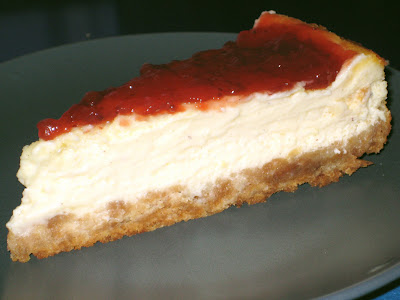 Spread out any jam of your liking on top, remove from the spring form, peel off the baking paper on the side and cut it with a clean knife. To get perfect slices every time, clean the knife and dip it in warm water between each cut. The result should speak for itself.
Spread out any jam of your liking on top, remove from the spring form, peel off the baking paper on the side and cut it with a clean knife. To get perfect slices every time, clean the knife and dip it in warm water between each cut. The result should speak for itself.



































